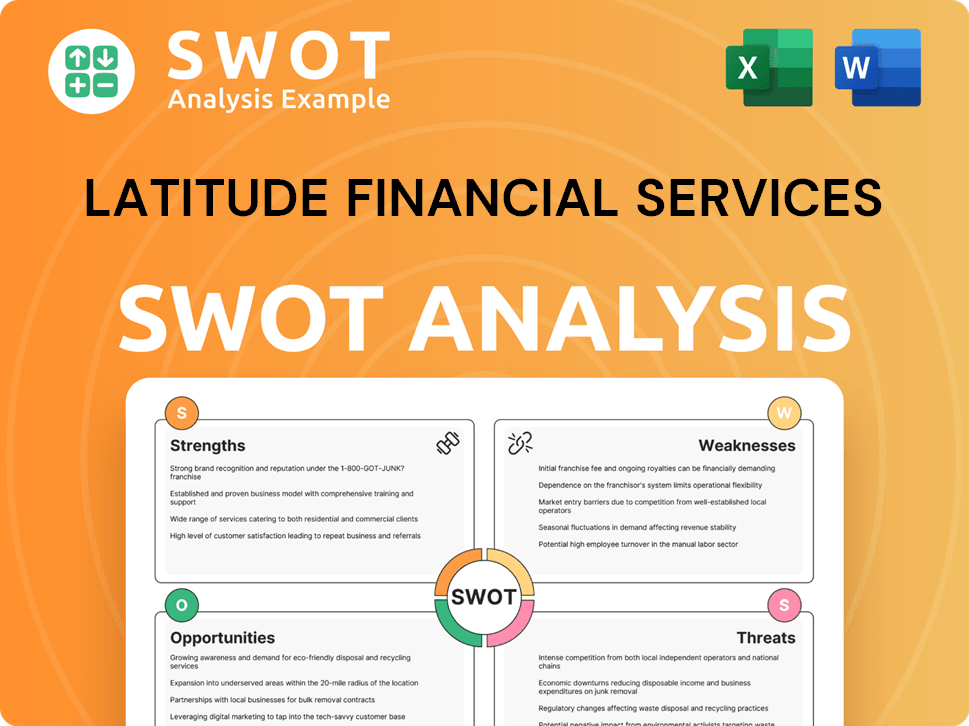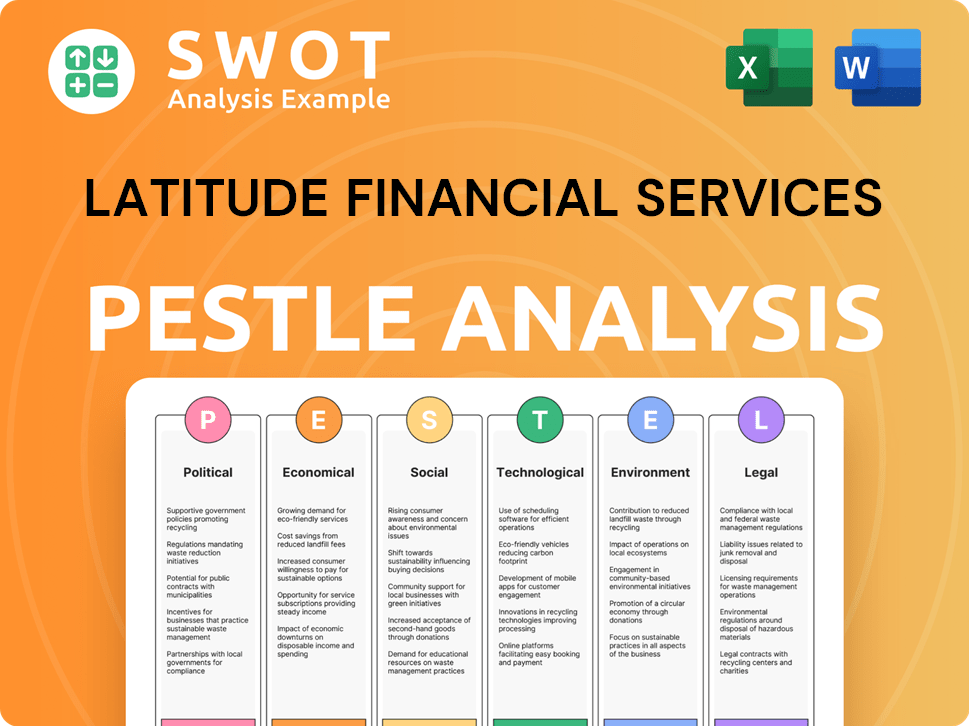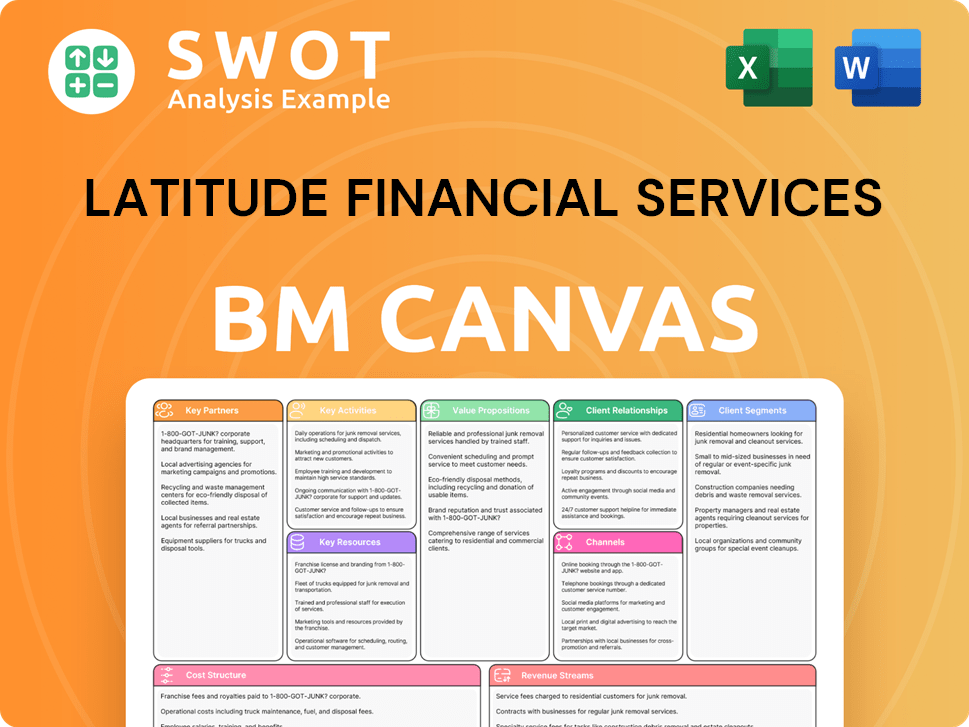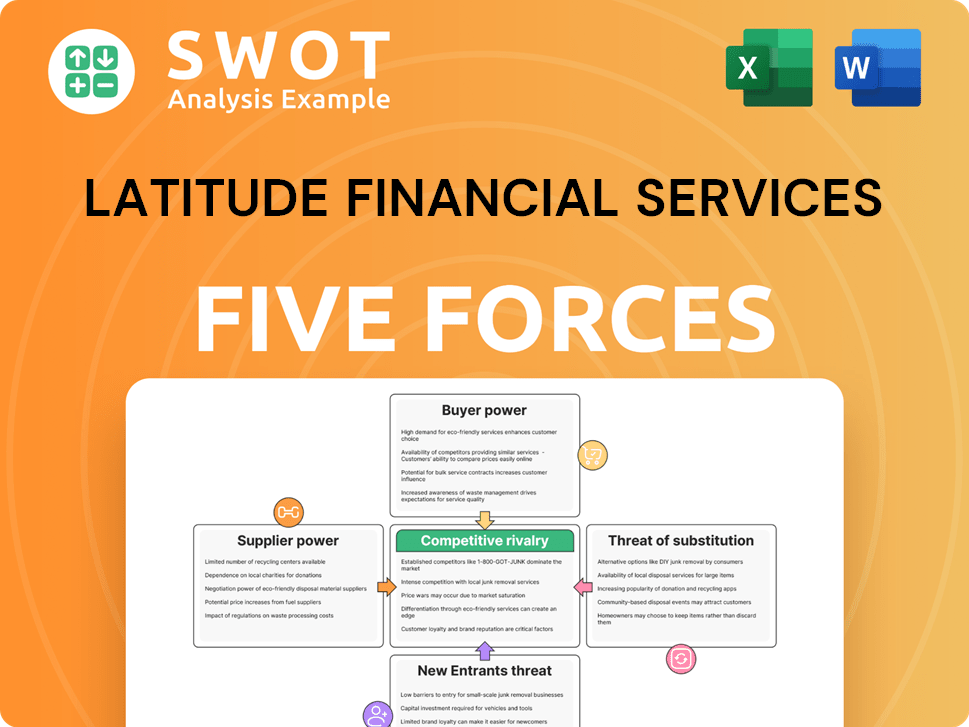Latitude Financial Services Bundle
Who Does Latitude Financial Services Serve?
In the fast-paced world of finance, understanding your customer is paramount. For Latitude Financial Services, navigating the evolving financial services industry requires a keen focus on its customer demographics and target market analysis. This deep dive explores how Latitude adapts to shifting consumer behavior and market segmentation to stay ahead.

This analysis will uncover the core customer demographics of Latitude Financial Services, examining aspects like age, income levels, and geographic distribution. We'll explore how Latitude identifies its target audience profile and the strategies it employs for customer acquisition and retention. Furthermore, we'll delve into demographic trends shaping the financial services sector, providing insights into understanding Latitude Financial customer needs and maximizing customer lifetime value.
Who Are Latitude Financial Services’s Main Customers?
Understanding the customer demographics and target market is crucial for any financial services company. For Latitude Financial Services, this involves a dual approach, catering to both consumers (B2C) and businesses (B2B) across Australia and New Zealand. This strategic focus allows Latitude to capture a diverse market, from individual consumers to retail partners.
The B2C segment is diverse, encompassing a wide age range and various financial needs. The B2B segment primarily involves partnerships with retailers to offer point-of-sale finance. This approach enables Latitude to tap into the growing demand for flexible payment options, enhancing customer experience and driving sales for its business partners.
Analyzing Latitude Financial Services' customer base reveals key insights into its market positioning and growth strategies. This analysis helps to tailor products and services to meet the specific needs of each segment, ensuring customer satisfaction and driving business success. A deeper dive into the specifics of each segment provides a more complete picture of the company's market approach.
The B2C segment includes a broad age range, from young adults to established households. Latitude offers credit cards and personal loans to a wide spectrum of income levels. Financial need and creditworthiness are key factors, with family status also playing a role in product selection. This segment reflects the company's commitment to financial inclusion.
The B2B segment primarily consists of retail enterprises of various sizes. These businesses partner with Latitude to offer point-of-sale financing options to their customers. This approach enhances customer experience and drives sales. The focus is on providing reliable financial technology and seamless onboarding processes.
The growth in online retail and the demand for 'buy now, pay later' solutions significantly impact Latitude's B2B segment. Latitude is enhancing its digital offerings and expanding retail partnerships. For the first half of the 2024 financial year, the company reported a statutory profit after tax of $29.7 million, reflecting its market adaptation.
Latitude's strategic pivot towards digital offerings and retail partnerships is driven by market research. This allows Latitude to capture a larger share of the consumer finance market. The company's focus on flexible financing options at the point of sale is a key element. The Growth Strategy of Latitude Financial Services highlights these market dynamics.
Latitude's target market analysis reveals a dual customer segment strategy. The B2C segment is broad, while the B2B segment focuses on retail partnerships. This approach allows Latitude to address the needs of diverse customers. The company's ability to adapt to market trends is crucial for continued success.
- Latitude serves both consumers and businesses across Australia and New Zealand.
- The B2C segment includes a wide range of ages and income levels.
- The B2B segment focuses on retail partnerships for point-of-sale financing.
- The company's strategic focus is on digital offerings and retail partnerships.
Latitude Financial Services SWOT Analysis
- Complete SWOT Breakdown
- Fully Customizable
- Editable in Excel & Word
- Professional Formatting
- Investor-Ready Format

What Do Latitude Financial Services’s Customers Want?
Understanding the customer needs and preferences is crucial for the success of any financial institution. For Latitude Financial Services, this involves a deep dive into the motivations and behaviors of its diverse customer base. This analysis helps tailor products and services to meet specific demands, ensuring customer satisfaction and loyalty. The following sections explore the key drivers behind customer decisions and how Latitude Financial Services adapts to these needs.
The primary needs of Latitude Financial Services customers revolve around convenience, flexibility, and accessibility to credit. Customers seek financial solutions that are easy to obtain and manage. This includes straightforward application processes, competitive interest rates, and transparent repayment terms. The demand for digital solutions, such as online account management and mobile accessibility, is paramount in today's fast-paced financial environment.
Customers are motivated by the need for funds for significant purchases or to manage unexpected expenses. They are looking for financial products that provide quick solutions and peace of mind. Positive customer experiences, competitive rates, and a diverse range of financial products are key factors in driving customer loyalty. Latitude Financial Services focuses on providing efficient and user-friendly solutions to bridge financial gaps, helping customers achieve their goals.
Customers require accessible and flexible credit options. They are driven by the need for funds for purchases or to manage unexpected expenses. Decision-making is influenced by interest rates, repayment terms, and ease of application.
Customers prefer digital and mobile-friendly solutions. Online account management and mobile accessibility are highly valued. There's a growing preference for BNPL options due to their convenience.
Positive customer experiences and competitive rates drive loyalty. The availability of diverse financial products that evolve with customer needs is also important. Manageable repayment plans provide peace of mind.
Customers seek peace of mind through manageable repayment plans. They need efficient solutions to bridge financial gaps. Aspirational goals include home improvements and debt consolidation.
Latitude Financial Services addresses the complexity of traditional loan applications. It provides immediate financing at the point of sale and offers transparent repayment structures. Customer feedback and market trends influence product development.
Latitude Financial Services tailors marketing and product features to specific segments. Partnerships with retailers highlight ease of financing at checkout. The focus on digital platforms reflects customer preferences for convenient financial solutions.
Latitude Financial Services focuses on understanding and meeting customer needs through various strategies. This includes providing flexible financial solutions and enhancing the customer experience through digital platforms. These strategies contribute to customer satisfaction and loyalty.
- Digital Transformation: Emphasis on online account management and mobile accessibility.
- Partnerships: Collaborations with retailers to offer financing at the point of sale.
- Product Development: Tailoring products to specific customer segments based on feedback and market trends.
- Customer Experience: Prioritizing ease of application and transparent repayment terms.
- Market Analysis: Continuous monitoring of customer behavior and preferences to adapt to changing needs.
Latitude Financial Services PESTLE Analysis
- Covers All 6 PESTLE Categories
- No Research Needed – Save Hours of Work
- Built by Experts, Trusted by Consultants
- Instant Download, Ready to Use
- 100% Editable, Fully Customizable

Where does Latitude Financial Services operate?
The primary geographic markets for Latitude Financial Services are Australia and New Zealand. The company has a strong market presence, particularly within the consumer finance sector in these regions. Its operations are largely focused on these two countries, where it has established a significant customer base and brand recognition.
Latitude's reach extends nationwide within Australia and New Zealand, leveraging digital platforms and retail partnerships. While the core products and services remain consistent across both countries, there are subtle differences in customer demographics and preferences influenced by local economic conditions and cultural nuances. This localized approach allows the company to tailor its offerings to better meet the specific needs of consumers in each market.
The company's strategic focus is on strengthening its core operations and partnerships within its established markets. There have been no significant announcements regarding international expansions beyond Australia and New Zealand. The geographic distribution of sales and growth is primarily concentrated within these two countries, driven by both direct-to-consumer channels and retail financing partnerships. This strategy allows Latitude to leverage its existing infrastructure and brand recognition to maximize growth.
Latitude Financial Services holds a significant market share in Australia and New Zealand's financial services industry. Precise market share figures fluctuate, but the company remains a key player. Understanding the customer demographics is crucial for tailored marketing strategies.
The geographic distribution of Latitude Financial Services customers is primarily concentrated in Australia and New Zealand. The company's reach is nationwide within these countries, with a strong presence in both urban and regional areas. This wide distribution is supported by both digital platforms and retail partnerships.
Latitude Financial Services employs customer segmentation strategies to better understand and serve its diverse customer base. These strategies involve segmenting customers based on various factors, including age, income, and spending habits. This approach allows for more targeted marketing campaigns.
Latitude Financial Services ensures its products comply with the respective regulatory frameworks in Australia and New Zealand. This compliance is essential for maintaining operations and building trust with customers. Adapting to local regulations is a key part of their strategy.
A thorough target market analysis is essential for Latitude Financial Services. This involves identifying the specific needs and preferences of customers within Australia and New Zealand. Understanding the customer demographics helps tailor products and marketing efforts. For further insights into customer demographics, you can refer to this article on customer demographic research.
- Age: Latitude Financial Services' customer base spans various age groups, with a significant portion likely falling within the 25-55 age range, reflecting the typical demographics of consumers seeking financial products.
- Income Levels: The target market includes individuals with diverse income levels, from those seeking credit cards to finance everyday expenses, to those looking for larger loans.
- Spending Habits: Understanding consumer spending habits is crucial for tailoring financial products and marketing strategies.
- Customer Acquisition Cost: The cost of acquiring new customers is carefully managed through targeted marketing campaigns and partnerships.
Latitude Financial Services Business Model Canvas
- Complete 9-Block Business Model Canvas
- Effortlessly Communicate Your Business Strategy
- Investor-Ready BMC Format
- 100% Editable and Customizable
- Clear and Structured Layout

How Does Latitude Financial Services Win & Keep Customers?
Customer acquisition and retention strategies are crucial for the success of any financial institution. For Latitude Financial Services, a multi-faceted approach is employed to attract and retain customers. This involves a blend of digital and traditional marketing, alongside strategic partnerships to reach the target market effectively. Understanding the customer demographics and tailoring strategies accordingly is key to growth within the financial services industry.
Digital marketing plays a significant role in Latitude Financial Services' acquisition strategy. This includes search engine marketing (SEM), social media advertising, and display advertising. The company also uses traditional marketing methods, such as television and radio advertisements, to build brand awareness. Furthermore, partnerships with retail partners offer point-of-sale finance solutions, which enables immediate customer onboarding.
Retention efforts focus on providing personalized experiences, often leveraging customer data and CRM systems. This data-driven approach allows for targeted communications. After-sales service, including accessible customer support and clear communication regarding account management, is critical for fostering long-term relationships.
Latitude Financial Services utilizes SEM, social media advertising, and display advertising to reach potential customers actively seeking financial products. These initiatives are designed to increase visibility and drive traffic to online platforms.
Point-of-sale financing solutions offered through retail partnerships provide immediate customer onboarding. This strategy simplifies the application process and enhances customer convenience. These partnerships expand Latitude Financial Services' reach and customer base.
Latitude Financial Services leverages customer data and CRM systems to personalize customer interactions. This data-driven approach allows for targeted communications, offering relevant products or services. This approach enhances customer satisfaction and loyalty.
Accessible customer support and clear communication regarding account management are critical for fostering long-term relationships. Providing excellent customer service helps to retain customers and build brand loyalty. This is a key aspect of the company's retention strategy.
The company's emphasis on digital transformation has aimed to improve customer loyalty and increase customer lifetime value. By focusing on these areas, Latitude Financial Services aims to reduce churn rates and provide a seamless financial experience. For more detailed information on the company's structure and ownership, see Owners & Shareholders of Latitude Financial Services.
Latitude Financial Services offers streamlined online application processes to provide quick approvals. This focus on efficiency appeals to a consumer base that values convenience. This approach helps attract and convert potential customers.
Offering competitive rates and flexible repayment options are part of the retention strategy. These initiatives aim to keep existing customers satisfied and encourage repeat business. This helps to improve customer lifetime value.
Using customer data to personalize communications and offer relevant products is a key strategy. This approach helps to improve customer engagement and increase sales. This targeted approach improves customer satisfaction.
Latitude Financial Services has been investing in digital transformation to enhance the customer journey. This includes improvements in application processes and account management. These efforts improve customer experience.
While not always overtly branded, loyalty programs are embedded in the value proposition of ongoing credit facilities. These programs provide incentives for customers to remain with the company. This boosts customer retention.
Providing accessible customer support and clear communication regarding account management is critical. This helps to ensure customer satisfaction and fosters long-term relationships. Excellent customer service is a priority.
Latitude Financial Services Porter's Five Forces Analysis
- Covers All 5 Competitive Forces in Detail
- Structured for Consultants, Students, and Founders
- 100% Editable in Microsoft Word & Excel
- Instant Digital Download – Use Immediately
- Compatible with Mac & PC – Fully Unlocked

Related Blogs
- What are Mission Vision & Core Values of Latitude Financial Services Company?
- What is Competitive Landscape of Latitude Financial Services Company?
- What is Growth Strategy and Future Prospects of Latitude Financial Services Company?
- How Does Latitude Financial Services Company Work?
- What is Sales and Marketing Strategy of Latitude Financial Services Company?
- What is Brief History of Latitude Financial Services Company?
- Who Owns Latitude Financial Services Company?
Disclaimer
All information, articles, and product details provided on this website are for general informational and educational purposes only. We do not claim any ownership over, nor do we intend to infringe upon, any trademarks, copyrights, logos, brand names, or other intellectual property mentioned or depicted on this site. Such intellectual property remains the property of its respective owners, and any references here are made solely for identification or informational purposes, without implying any affiliation, endorsement, or partnership.
We make no representations or warranties, express or implied, regarding the accuracy, completeness, or suitability of any content or products presented. Nothing on this website should be construed as legal, tax, investment, financial, medical, or other professional advice. In addition, no part of this site—including articles or product references—constitutes a solicitation, recommendation, endorsement, advertisement, or offer to buy or sell any securities, franchises, or other financial instruments, particularly in jurisdictions where such activity would be unlawful.
All content is of a general nature and may not address the specific circumstances of any individual or entity. It is not a substitute for professional advice or services. Any actions you take based on the information provided here are strictly at your own risk. You accept full responsibility for any decisions or outcomes arising from your use of this website and agree to release us from any liability in connection with your use of, or reliance upon, the content or products found herein.